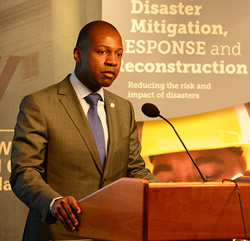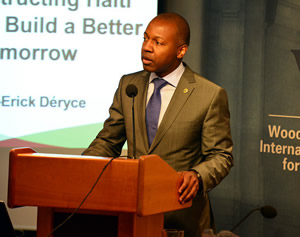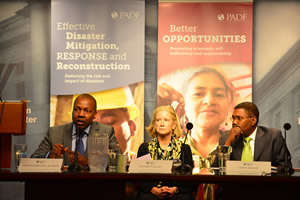Ambassador Paul G. Altidor spoke at The Wilson Center January 10, 2013, at an event commemorating the third anniversary of the earthquake in Haiti. The event, “Recovery, Reconstruction and Renewal: What it Takes to Build Back Better in Haiti, was co-hosted by the comparative urban studies project and the Latin American Program of The Wilson Center and the Pan American Development Foundation.
| Click here to see the Photo Gallery | Click here to watch the video |
Below, please find the full text of Ambassador Altidor’s prepared remarks:
 I would like to thank The Wilson Center and PADF for hosting today’s event and providing me with the opportunity to discuss the recovery and reconstruction efforts in Haiti since the 2010 earthquake and share with you the Government of Haiti’s strategy to spur economic development and get development right.
I would like to thank The Wilson Center and PADF for hosting today’s event and providing me with the opportunity to discuss the recovery and reconstruction efforts in Haiti since the 2010 earthquake and share with you the Government of Haiti’s strategy to spur economic development and get development right.
Reconstruction Process
As you are aware, more than 200,000 people perished on that day, leaving more than 1.5 million internally displaced. The earthquake further devastated the Haitian government, with the majority of government buildings destroyed. Contrary to some of the reports or storylines being repeated in the international press, Haiti has made tremendous progress in the last three years, both in terms of reconstruction and in terms of strengthening the Haitian state and its institutions.
With the democratic election of President Martelly in 2011, the country has been aggressively moving forward, determined to get development right.
We are beginning to see real change. Since President Martelly was sworn in, Haiti has made substantial progress in reducing the number of people displaced by the earthquake living in tents. There were nearly 1.5 million people living in 1,550 tent camps when President Martelly took office. The number of displaced Haitians is now less than 400,000 due to the implementation of the government’s relocation strategy. Gradually, the major public spaces are being vacated as 1,100 of the 1,500 camps have been closed. The government was able to reduce the number of people in the camps through a combination of rent subsidies, provision of new housing, rehabilitation and repair of damaged houses, and support encouraging individuals to return to their communities of origin. All of these actions are part of a long-term housing strategy put in place by the government. One of the key aspects of this strategy is that the Government of Haiti no longer seeks to build temporary shelters, but rather to build permanent housing. The government will continue to work with NGOs to ensure that this policy is followed.
The government also has made significant progress in removing the rubble and repairing the homes that were damaged during the 2010 earthquake. Between 60-70% of the debris has been removed and 300,000 houses have been repaired. To address housing constraints, the government has encouraged the move towards expanding high-density living with the introduction of mult-istory condos and apartments; and is working to provide financing for strengthening existing homes.
The government is also beginning to construct public buildings destroyed during the earthquake. Nearly 60% of government buildings and 80% of schools in Port-au-Prince were destroyed during the earthquake. The human toll of the earthquake was equally devastating with a quarter of civil servants in Port-au- Prince killed. The government is using its own funds to begin rebuilding 42 public buildings destroyed during the 2010 earthquake. Just last week, Prime Minister Laurent Lamothe oversaw the laying of the first stone on the planned Parliament building in Port-au-Prince.
Challenges and Lessons Learned
 Those are some examples of the successes achieved during the reconstruction efforts. During this process, the country also faced a number of challenges, which has slowed the reconstruction process. Allow me to share a few of these challenges:
Those are some examples of the successes achieved during the reconstruction efforts. During this process, the country also faced a number of challenges, which has slowed the reconstruction process. Allow me to share a few of these challenges:
First, there was a lack of coordination between the international community’s efforts and that of the government. This resulted in a misallocation of resources and duplication of efforts.
Second, for too long, the nearly 10,000 NGOs operating in the country were not required to be accountable to the government or the Haitian people. With the majority of the assistance to Haiti going through these NGOs rather than the Haitian government, the Haitian state has remained in a weak state and the funds funneled to the country have not produced the desired results.
In an effort to address these first two points, the government has adopted a new donor coordination mechanism, which is designed to align the work of the NGOs operating in Haiti with the national development strategy and ensure that the NGOs coordinate their initiatives with the government rather than bypassing the government.
Third, only a fraction of the billions pledged by the international community has been delivered. The lack of funds has hampered and slowed the reconstruction process greatly.
Getting Development Right
Haiti is now at a crossroads for galvanizing its endowments and generating sustainable, long-term economic growth. There are multiple development efforts currently underway in Haiti aimed at spurring greater economic growth, including the ambitious development of major infrastructure and housing programs, the construction of two international airports, the focus on energy, the revitalization of the tourism sector, and the constructing of industrial parks such as Caracol in the north of the country to expand the country’s export base. The government is also actively focused on addressing investment promotion, directly tackling extreme poverty, increasing agricultural production, expanding school enrollment, and the empowerment of women.
These efforts have started to yield results. Some of the government’s key achievements, which merit highlighting include:
- Approximately one million school-aged children are now able to gain access to schooling, thanks to subsidized tuition, free school lunches and free transportation. The government also is expecting to build 13,470 classrooms in the next four years.
- Social Safety Nets program to the most vulnerable: the government adopted a conditional cash transfer program which is providing assistance to 100,000 women with $15 million of Haitian government funds.
- Steps have been taken to address the much-needed judicial reform and to combat corruption.
- In terms of the private sector, legislation has been introduced which will reduce the time it takes to open a new business in the country from 105 days to 10 days.

Before closing, I would also like to highlight one aspect of the development process that directly involves me as the Haitian Ambassador to the U.S. The centerpiece of Haiti’s foreign policy is what we refer to as “business diplomacy.” What it means is that our foreign missions and consulates are now re-oriented and empowered to serve as conduits for potential investors. Our diplomatic missions around the world now serve as instruments to attract foreign direct investment in Haiti, to encourage open markets for Haitian products and to support the interest of Haitian entrepreneurs and businesses.
I have spoken enough. As you can see, there has been progress in the reconstruction efforts. The government of Haiti is taking ownership of the country’s development agenda. Our intent is to get development right this time for Haiti and its people. We are working tirelessly to that end. Once again, thank you to the Woodrow Wilson Center for giving me the opportunity to address you.

